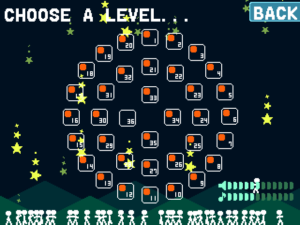
Today we have a short, simple article for a short, simple game. Hanano Puzzle, which roughly means “Puzzle of Flowers”, aims to create a calm and relaxing atmosphere with pleasant music, backgrounds filled with gently falling confetti-like shapes, and happy stickfigure people jumping around on the stage select screen. There’s no time pressure and no rankings based on the number of moves you make, but there is a happy message to congratulate you after you complete a stage and it even occasionally suggests for you to take a break after some of the stages so that you don’t exhaust yourself. Don’t be fooled by the warm and cozy atmosphere though – this is one of the most brainmeltingly devious puzzle games out there.
The basic mechanics behind Hanano Puzzle are remarkably simple. Each level contains red, blue, and/or yellow blocks which you can swap horizontally, and only horizontally, with the mouse. In addition to these blocks, there are flowers growing in the walls. Move a block so that it is touching a flower of the same color from any cardinal direction and the block will grow into a two-tile rectangle with its own flower in the top half. The goal of each stage is to make every colored block ‘bloom’ and you can even use the flowers sprouting from colored blocks to affect other blocks. There aren’t any warps or keys or hazards or moving platforms to worry about either. Sounds easy, doesn’t it?
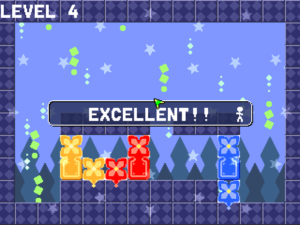 Well, there are a few basic rules to be aware of here. First, blocks obey gravity and can only bloom if they are firmly next to a flower, so swapping a block to put it next to a flower growing out of the side of the wall won’t make it bloom if doing so puts the block above a pit. Secondly, the bloomed two-tile blocks can’t be swapped with multiple blocks simultaneously so. For example, if two blue blocks are stacked together and you want to swap positions with an adjacent bloomed red block, you will need to move the upper blue block away to swap the red block with the lower blue one. The third, final, and most important rule for colored blocks is that blocks will bloom whenever possible, but only if they have enough space to do so. For this scenario, let’s say there is a red flower on the left, a yellow block stacked on top of a blue block next to it, and to the right of this stack is a lone red block; swapping the red block with the blue block would normally make the red block bloom, pushing the yellow block up one tile along the way, but if the yellow block is already pressing up against the ceiling the red block would not be able to bloom until the yellow block was moved because there would not be enough space.
Well, there are a few basic rules to be aware of here. First, blocks obey gravity and can only bloom if they are firmly next to a flower, so swapping a block to put it next to a flower growing out of the side of the wall won’t make it bloom if doing so puts the block above a pit. Secondly, the bloomed two-tile blocks can’t be swapped with multiple blocks simultaneously so. For example, if two blue blocks are stacked together and you want to swap positions with an adjacent bloomed red block, you will need to move the upper blue block away to swap the red block with the lower blue one. The third, final, and most important rule for colored blocks is that blocks will bloom whenever possible, but only if they have enough space to do so. For this scenario, let’s say there is a red flower on the left, a yellow block stacked on top of a blue block next to it, and to the right of this stack is a lone red block; swapping the red block with the blue block would normally make the red block bloom, pushing the yellow block up one tile along the way, but if the yellow block is already pressing up against the ceiling the red block would not be able to bloom until the yellow block was moved because there would not be enough space.
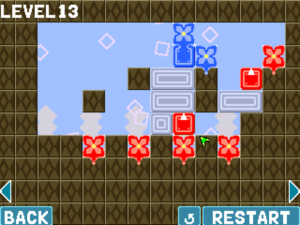 Though nothing particularly strange or complicated gets added into the mix, there are two very important additions which appear fairly early on. Stone blocks come in all sizes, though always as squares or rectangles, and can be pushed, swapped, and made to fall just like colored blocks. However, with this new type of block comes a new lesson; blocks which are more than one tile wide can never be swapped with other blocks regardless of if they are small 1×2 platforms or giant 6×6 barriers. With this addition the game changes dramatically as before the placement of every block ultimately ended next to a flower in the wall or a flower in a matching block, but now you have pieces which only serve to get in the way, which must be lowered to allow the passage of some blocks and raised from below to lift up others, and which must be carefully juggled and maneuvered so that every colored block can bloom.
Though nothing particularly strange or complicated gets added into the mix, there are two very important additions which appear fairly early on. Stone blocks come in all sizes, though always as squares or rectangles, and can be pushed, swapped, and made to fall just like colored blocks. However, with this new type of block comes a new lesson; blocks which are more than one tile wide can never be swapped with other blocks regardless of if they are small 1×2 platforms or giant 6×6 barriers. With this addition the game changes dramatically as before the placement of every block ultimately ended next to a flower in the wall or a flower in a matching block, but now you have pieces which only serve to get in the way, which must be lowered to allow the passage of some blocks and raised from below to lift up others, and which must be carefully juggled and maneuvered so that every colored block can bloom.
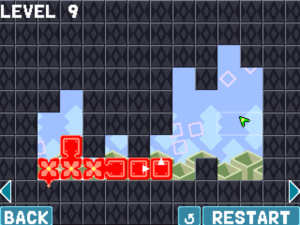 Bloom direction is the final element added to the mix and it’s one the game hints at from the very beginning; every colored block has a white arrow in it and for the first dozen or so levels these arrows always point upwards, but this arrow can actually point in any cardinal direction to indicate the way in which the block will bloom. Like with stone blocks, blocks with horizontal arrows can no longer be swapped with other blocks once they bloom, but they serve as much as a tool as a hindrance since they allow you to push groups of block horizontally when they grow. Directional blooming means you can no longer focus only on getting blocks of a certain color to matching flowers and must instead pay attention to every individual block. Now you can place blocks on the ground, which would have previously made the level unwinnable if a matching flower was not also on the ground as there would be no way to raise them, because doing so may let you reach the right flower with a downward-blooming block. Now you can stack a horizontally-blooming block on top of an upward one to form a mobile bridge. Now there are far more possible moves, techniques, and combinations than before and Hanano Puzzle will make sure you use them as effectively as possible as it tosses out one seemingly-impossible puzzle after another.
Bloom direction is the final element added to the mix and it’s one the game hints at from the very beginning; every colored block has a white arrow in it and for the first dozen or so levels these arrows always point upwards, but this arrow can actually point in any cardinal direction to indicate the way in which the block will bloom. Like with stone blocks, blocks with horizontal arrows can no longer be swapped with other blocks once they bloom, but they serve as much as a tool as a hindrance since they allow you to push groups of block horizontally when they grow. Directional blooming means you can no longer focus only on getting blocks of a certain color to matching flowers and must instead pay attention to every individual block. Now you can place blocks on the ground, which would have previously made the level unwinnable if a matching flower was not also on the ground as there would be no way to raise them, because doing so may let you reach the right flower with a downward-blooming block. Now you can stack a horizontally-blooming block on top of an upward one to form a mobile bridge. Now there are far more possible moves, techniques, and combinations than before and Hanano Puzzle will make sure you use them as effectively as possible as it tosses out one seemingly-impossible puzzle after another.
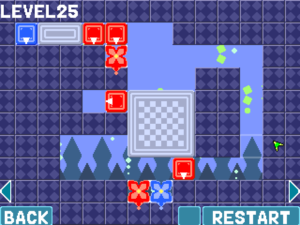
Simplicity really is what makes Hanano Puzzle work as well as it does. All of its mechanics and elements are introduced early on and the rules for how they function and how they can be manipulated are intuitive and easy to learn. With no need to worry about timing or cumbersome physics the only focus is on how to position blocks and which order to use them in. This simplicity also extends to the level design; it may give you blocks which are designed to get in the way, but this game will never give you more pieces than you need and no piece is ever without purpose. The best way to solve a level is often to interact with it and play around with the blocks, to eliminate what really is impossible in order to gain a better understand of what the puzzle is asking you to do and then take steps to accomplish that task. These puzzles are brutal in their simplicity as they demand complete efficiency. I mentioned earlier that there isn’t a ranking system for how many moves it takes you to solve a puzzle, but the truth is that this is for more than the sake of a relaxed atmosphere – there isn’t a move counter because the places in which you can afford to make an incorrect move are so few that a single block placed in the wrong location or a single block bloomed at the wrong time will almost certainly make the puzzle impossible to solve.
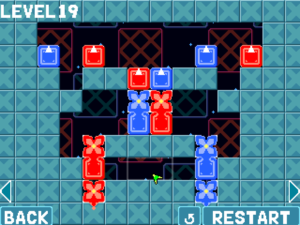 Hanano Puzzle’s difficulty may generally be extremely high, but it takes a somewhat unusual approach. Rather than constantly cranking up the difficulty puzzle after puzzle, it is more akin to walking across a series of gradually larger hills than scaling a mountain. It’ll give you complicated puzzles with plenty of pieces, but it always makes sure to follow them up with smaller puzzles where the goal is to cleverly use a handful of blocks in a limited amount of space. There is a general increase in difficulty along the way, but there are deliberate, and much-needed, small dips along the way. As satisfying as it is to solve a puzzle which I’ve been banging my head against for nearly an hour, it is always nice to follow it up with one or two easier, though certainly not easy, puzzles which can be solved in about 15 minutes or less. Changes in backgrounds and songs between levels are also common and help to give a real sense of progression. The only places where Hanano Puzzle stumbles slightly are in its skipping and undo features. For the skipping feature, the issue is that it simply doesn’t exist and if you get stuck on a stage you must finish it before you can move on; the amount of puzzles here number in the dozens and not in the hundreds, but it would have benefitted from allowing players to skip a puzzle or two. As to the undo feature, it actually exists, but it’s not very useful as it only allows you to undo the most recent move. I’m glad this feature exists at all because it’s still great for if you accidentally move a block off a ledge or next to a flower when you meant to move a different block, but the only way to correct any other sort of mistake is to simply start the level from the beginning.
Hanano Puzzle’s difficulty may generally be extremely high, but it takes a somewhat unusual approach. Rather than constantly cranking up the difficulty puzzle after puzzle, it is more akin to walking across a series of gradually larger hills than scaling a mountain. It’ll give you complicated puzzles with plenty of pieces, but it always makes sure to follow them up with smaller puzzles where the goal is to cleverly use a handful of blocks in a limited amount of space. There is a general increase in difficulty along the way, but there are deliberate, and much-needed, small dips along the way. As satisfying as it is to solve a puzzle which I’ve been banging my head against for nearly an hour, it is always nice to follow it up with one or two easier, though certainly not easy, puzzles which can be solved in about 15 minutes or less. Changes in backgrounds and songs between levels are also common and help to give a real sense of progression. The only places where Hanano Puzzle stumbles slightly are in its skipping and undo features. For the skipping feature, the issue is that it simply doesn’t exist and if you get stuck on a stage you must finish it before you can move on; the amount of puzzles here number in the dozens and not in the hundreds, but it would have benefitted from allowing players to skip a puzzle or two. As to the undo feature, it actually exists, but it’s not very useful as it only allows you to undo the most recent move. I’m glad this feature exists at all because it’s still great for if you accidentally move a block off a ledge or next to a flower when you meant to move a different block, but the only way to correct any other sort of mistake is to simply start the level from the beginning.
There is nothing wrong with a puzzle game which chooses to have varied mechanics or to provide players with multiple valid solutions, Burnstar and Toki Tori 2 are both amongst my favorite puzzle games, but Hanano Puzzle shows that there can be strength in simplicity. Qrostar has made a relaxing game which refuses to hold your hand and its puzzles push both the mechanics and players alike to their limits and that’s just great.
Official Website: http://qrostar.skr.jp/index.cgi?page=hanano&lang=en